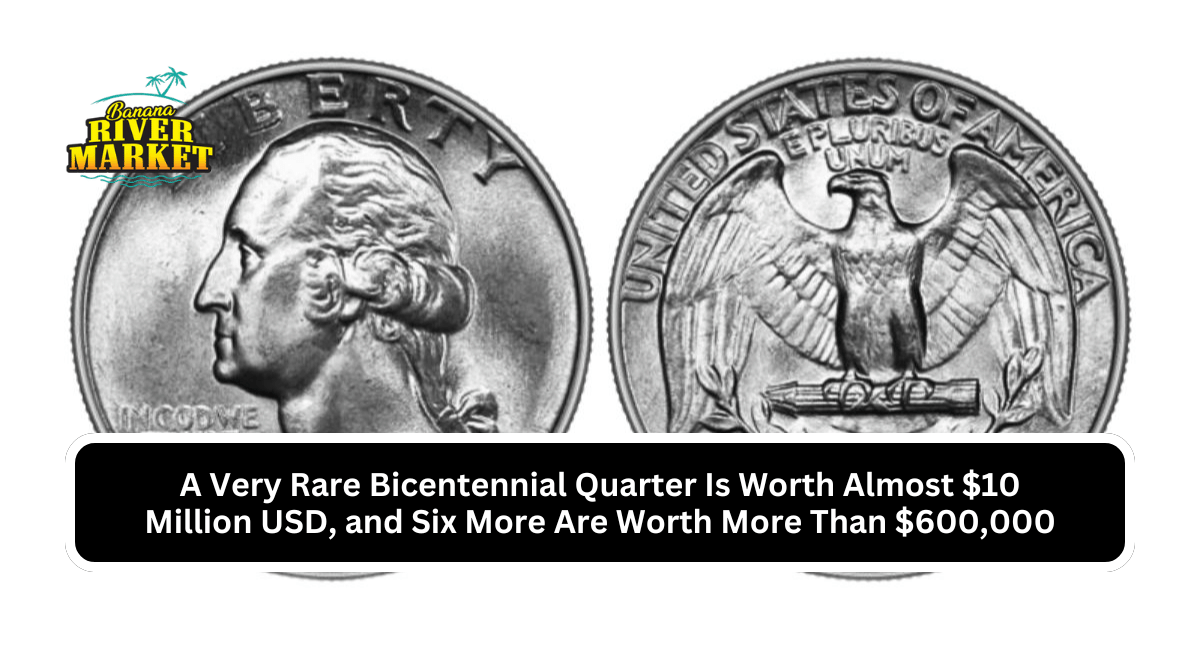The 1976 Bicentennial Quarter was struck in commemoration of the United States’ 200th anniversary. Although billions were made, only a small number of unusual coins have appreciated over time.
Due to specific minting faults, unique compositions, and almost ideal circumstances, these shared quarters have become highly valued collectibles valued at hundreds and, in some cases, millions of dollars.
1. The Quarter of Bicentennial, $10 Million
There is a 1976 Bicentennial quarter that is said to be worth about $10 million! It is valuable because of its immaculate condition and an uncommon mix of metal composition and minting faults.
This coin is a remarkable gem among collectors due to its distinctive features, which are said to include a rare double die or mistake. This quarter’s specifics remain unknown because it is supposedly kept in a private collection.
2. Error Double Die Obverse
The Double Die Obverse (DDO) fault is a unique minting error in which the design is struck twice, giving some areas of the coin, like the date or text, a “doubled” appearance.
These quarters are precious because of their striking visual doubling effect. DDO Bicentennial Quarters may fetch over $600,000 in almost excellent condition.
3. The Bicentennial Silver Quarters
Although copper-nickel was used to make the majority of Bicentennial Quarters, a small quantity was struck in 40% silver for collectors. These silver versions were part of unique sets in addition to silver half-dollar and dollar coins.
Due to their peculiar composition, high-grade silver Bicentennial Quarters are uncommon, especially in perfect or perfect condition, and may fetch over $600,000.
4. Error Coin Proof
Typically designed for collectors, proof coins are struck with remarkable detail and a smooth surface. However, certain Proof Bicentennial Quarters were discovered to have minor misalignments, die fractures, or duplicate strikes.
Rare bits of these proof mistakes are valuable and may sell for over $600,000. The juxtaposition between the proof’s intended precision and the mistake’s uniqueness makes these coins very valuable to collectors.
5. Strike Quarters Off-Center
A misaligned coin blank (planchet) results in an off-center strike mistake, which makes the design seem skewed. Significant shifts give the coin a unique appearance and rarity, whereas minor off-center strikes are less desirable.
Bicentennial quarters with notable off-center strikes can fetch over $600,000 when in uncirculated condition and are, therefore, very desirable.
6. Mistakes in the Planchet
The incorrect striking of a Bicentennial Quarter on a blank intended for a different denomination, such as a dime, is known as a wrong planchet error. Coins made with this error are not the same size or weight as regular quarters.
When in good condition, these coins may fetch over $600,000. They are pretty uncommon. Their unintentional construction makes them more intriguing and appealing.
7. Bicentennial High-Grade Quarters (MS68 or Higher)
Due to the extensive circulation of most Bicentennial Quarters, coins in near-perfect condition (graded MS68 or better) are scarce. These coins are nearly flawless, with their original brilliance and detail intact.
A perfect Bicentennial Quarter can fetch over $600,000, particularly if it has a rare minting fault.
Particularly Valuable Bicentennial Quarters
| Bicentennial Quarter Type | Unique Feature | Approximate Value (USD) |
|---|---|---|
| $10 Million Bicentennial Quarter | Unique metal composition/error | Nearly $10 million |
| Double Die Obverse | Doubled design effect | Over $600,000 |
| Silver Bicentennial | 40% silver composition | Over $600,000 |
| Proof Error | Proof coin with mint errors | Over $600,000 |
| High-Grade MS68 or Higher | Pristine, flawless condition | Over $600,000 |
Bicentennial quarters from 1976 have become a collector’s paradise. Although most are valuable on their face, uncommon types have become extremely valuable because of particular flaws, unusual metal compositions, or unusually high grades. These coins are still valued in the numismatic field because they represent a significant moment in American history.
FAQs
Q1: Why do certain Bicentennial Quarters have such high values?
High-grade conditions, unique silver compositions, or uncommon minting faults make some Bicentennial Quarters extremely valuable. Because of these characteristics, they are precious to collectors and distinctive.
Q2: What is the best way to determine the value of my Bicentennial Quarter?
Verify whether it’s a silver version or has off-center hits or double-die effects. Accurately grading it increases its worth, which may verify its condition and perhaps disclose a high grade.
Q3: Do Bicentennial Quarters still exist today?
Indeed, although they are less often than regular quarters, rare editions, particularly those with distinctive mistakes or compositions, are typically found in private collections or sold at auction.
Q4: How can I receive a grade for the Bicentennial Quarter?
You may get your quarter rated by sending it to a reputable grading agency, such as the Numismatic Guaranty Corporation (NGC) or the Professional Coin Grading Agency (PCGS). They provide official grading and a protective case.
Q5: What is the value of the Bicentennial Quarters proof error?
Bicentennial Quarters are valued because proof coins are made with such care and accuracy that any mistakes are uncommon and highly prized by collectors.
Q6: Are all Bicentennial quarters made of silver worth anything?
Bicentennial quarters made with silver are often worth more than those made of copper and nickel. However, not all of them are very valuable. Condition and unique qualities, like mistakes or excellent grades, significantly increase value.
READ MORE: Rare Bicentennial Quarter: Six More Worth Over $500,000 USD Nearly $10 Million

